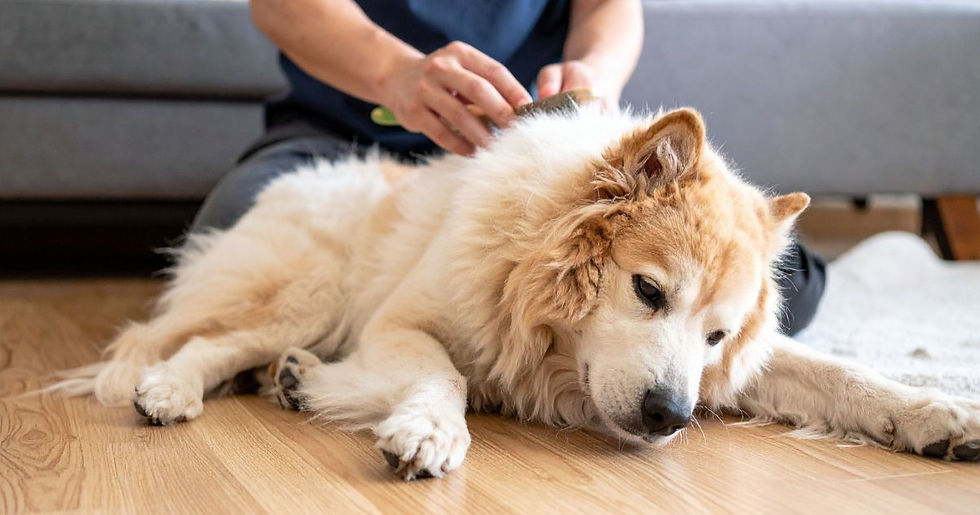How Groomers Can Spot Warning Signs in Senior Pets
- Dr. Liz Munro

- Sep 29
- 3 min read

Grooming sessions are more than just a trim or tidy-up—especially for senior pets. Regular grooming provides an invaluable opportunity to spot early warning signs of health changes that may go unnoticed at home. For many owners, groomers are trusted partners in their pet’s wellbeing.
This guide explores how groomers can help identify physical or behavioural changes in older pets, and why it’s important for owners to take their observations seriously.
Contents
Why Grooming Is a Key Touchpoint for Older Pets
What Groomers Might Notice First
Signs That May Need Veterinary Attention
How Owners Can Support Early Detection
FAQs
Why Grooming Is a Key Touchpoint for Older Pets
Senior pets often require more frequent grooming—not just for hygiene, but to manage changes in coat texture, skin condition, and comfort. Regular appointments mean groomers get hands-on with your pet and may be the first to spot subtle changes that could signal underlying health issues.
For owners, especially those with long-haired breeds or mobility-restricted pets, groomers provide more than just a service—they are an extra set of eyes. Their consistency and close contact make them ideally placed to notice changes that might otherwise be missed between vet visits.
What Groomers Might Notice First
Because of their tactile work, groomers often pick up on physical changes well before they become visible or symptomatic. Common early signs they may spot include:
New lumps, bumps, or skin growths
Unusual thinning or matting of fur
Changes in skin texture, such as dryness, flaking, or inflammation
Weight loss—especially in areas like the hips, ribs, and spine
Pain or stiffness when lifting legs or handling joints
Odours from ears, mouth, or skin that may suggest infection
Sudden behavioural shifts, like flinching, growling, or reluctance to stand
These observations might indicate anything from arthritis to infections to more serious conditions like cancer. Groomers are not trained to diagnose, but their input can prompt early vet visits that lead to timely intervention.
Signs That May Need Veterinary Attention
While some physical quirks are harmless, others can be early symptoms of illness or pain. If a groomer reports any of the following, it’s worth booking a veterinary check:
A new or growing lump—especially if it's firm, irregular, or changing
A noticeable drop in weight since the last visit
Consistent flinching or vocalising during grooming
Unusual skin changes like redness, crusting, or discharge
Foul smells from ears or skin that persist despite cleaning
Refusal to be handled, especially in previously tolerant pets
Many of these issues are more manageable when caught early. For senior pets, early detection can dramatically improve outcomes and comfort.
How Owners Can Support Early Detection
You don’t need to rely on the groomer alone. As a pet owner, you can turn grooming appointments into a collaborative approach to health monitoring:
Ask your groomer to share observations, even if they seem minor
Track changes over time—e.g. note if a lump is getting larger between grooms
Schedule regular vet checks, especially if grooming reveals something new
Thank and encourage your groomer for raising concerns—they may help detect a serious issue before symptoms escalate
Follow up promptly on any concerns with a professional diagnosis
Groomers often build close relationships with their senior clients and want what’s best for them. Acting on their concerns shows you value their role in your pet’s care.
FAQs
Can groomers diagnose medical problems?
No. Groomers are not medical professionals, but they are skilled at noticing physical and behavioural changes. Their observations can prompt early vet visits that lead to diagnosis.
How often should senior pets be groomed?
Many older pets benefit from more frequent grooming—every 4–8 weeks depending on breed and coat type. This helps maintain hygiene and allows regular checks for changes in health.
Should I ask my groomer to report any changes?
Yes. Encourage open communication. Let your groomer know you welcome their feedback about lumps, coat condition, behaviour, or anything unusual they spot.
What if my pet suddenly resists grooming?
Sudden resistance—like growling, snapping, or restlessness—can be a sign of pain or discomfort. It may indicate arthritis, dental issues, or other conditions that should be evaluated by a vet.
Can grooming reveal serious health problems?
Yes. Groomers may be the first to notice weight loss, skin disease, pain, or lumps that owners haven’t seen. While they can't treat these issues, their insights can be life-saving if followed up promptly.















